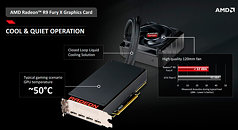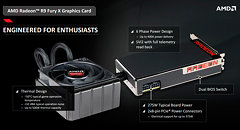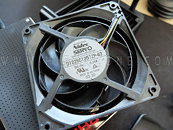Monday, June 22nd 2015

AMD "Fiji" Block Diagram Revealed, Runs Cool and Quiet
AMD's upcoming flagship GPU silicon, codenamed "Fiji," which is breaking ground on new technologies, such as HBM, memory-on-package, a specialized substrate layer that connects the GPU with it, called Interposer; features a hefty feature-set. More on the "Fiji" package and its memory implementation, in our older article. Its block diagram (manufacturer-drawn graphic showing the GPU's component hierarchy), reveals a scaling up, of the company's high-end GPU launches over the past few years.
"Fiji" retains the quad Shader Engine layout of "Hawaii," but packs 16 GCN Compute Units (CUs), per Shader Engine (compared to 11 CUs per engine on Hawaii). This works out to a stream processor count of 4,096. Fiji is expected to feature a newer version of the Graphics CoreNext architecture than "Hawaii." The TMU count is proportionately increased, to 256 (compared to 176 on "Hawaii"). AMD doesn't appear to have increased the ROP count, which is still at 64. The most significant change, however, is its 4096-bit HBM memory interface, compared to 512-bit GDDR5 on "Hawaii."At its given clock speeds, of up to 1050 MHz core, with 500 MHz memory (512 GB/s bandwidth), on the upcoming Radeon R9 Fury X graphics card, "Fiji" offers a GPU compute throughput of 8.6 TFLOP/s, which is greater than the 7 TFLOP/s rated for NVIDIA's GeForce GTX Titan X. The reference board may draw power from a pair of 8-pin PCIe power connectors, but let that not scare you. Its typical board power is rated at 275W, just 25W more than the GTX Titan X, for 22% higher SPFP throughput (the two companies may use different methods to arrive at those numbers).
AMD claims that the reference cooling solution will pay heavy dividends in terms of temperatures and noise. In a typical gaming scenario, the temperatures will be around 50°C, and noise output under 32 dB. To put these into perspective, the reference NVIDIA GeForce GTX Titan X, sees its load temperatures reach 84°C, and its fan puts out 45 dB, in our testing. The cooling solution is confirmed to feature a Nidec-Servo made 120 mm fan. As with all flagship graphics cards over the past few generations, Radeon R9 Fury X will feature dual-BIOS, and ZeroCore (which powers down the GPU when the display-head is idling, and completely powers down non-primary GPUs in CrossFire setups, unless 3D loads warrant the driver to power them back up).
The Radeon R9 Fury X will be priced at US $649.99, and will be generally available in the next 3 or so weeks.
Source:
Hispazone
"Fiji" retains the quad Shader Engine layout of "Hawaii," but packs 16 GCN Compute Units (CUs), per Shader Engine (compared to 11 CUs per engine on Hawaii). This works out to a stream processor count of 4,096. Fiji is expected to feature a newer version of the Graphics CoreNext architecture than "Hawaii." The TMU count is proportionately increased, to 256 (compared to 176 on "Hawaii"). AMD doesn't appear to have increased the ROP count, which is still at 64. The most significant change, however, is its 4096-bit HBM memory interface, compared to 512-bit GDDR5 on "Hawaii."At its given clock speeds, of up to 1050 MHz core, with 500 MHz memory (512 GB/s bandwidth), on the upcoming Radeon R9 Fury X graphics card, "Fiji" offers a GPU compute throughput of 8.6 TFLOP/s, which is greater than the 7 TFLOP/s rated for NVIDIA's GeForce GTX Titan X. The reference board may draw power from a pair of 8-pin PCIe power connectors, but let that not scare you. Its typical board power is rated at 275W, just 25W more than the GTX Titan X, for 22% higher SPFP throughput (the two companies may use different methods to arrive at those numbers).
AMD claims that the reference cooling solution will pay heavy dividends in terms of temperatures and noise. In a typical gaming scenario, the temperatures will be around 50°C, and noise output under 32 dB. To put these into perspective, the reference NVIDIA GeForce GTX Titan X, sees its load temperatures reach 84°C, and its fan puts out 45 dB, in our testing. The cooling solution is confirmed to feature a Nidec-Servo made 120 mm fan. As with all flagship graphics cards over the past few generations, Radeon R9 Fury X will feature dual-BIOS, and ZeroCore (which powers down the GPU when the display-head is idling, and completely powers down non-primary GPUs in CrossFire setups, unless 3D loads warrant the driver to power them back up).
The Radeon R9 Fury X will be priced at US $649.99, and will be generally available in the next 3 or so weeks.





73 Comments on AMD "Fiji" Block Diagram Revealed, Runs Cool and Quiet
It's water cooled
No HDMI 2.0
4GB HBM1
Is that it? I know I could throw in driver support, but as hard as it is to justify the other "issues" considering it hasn't even been released yet, it's really hard to complain about drivers. I can't even keep a straight face with the others.
/Sarcasm
but it's not the 3xx line that we want here (after all i have a 390 since 1 yrs and a half now ... woops 290 sorry) but Fiji, so what will the the ratio watt to performance (well more interested in performance summary than in consumption )
I'm just amazed what he used to do, can't imagine the stuff he goes through now.
in fact i didn't really care about the chart posted (i usually read my reviews on TPU only ... )
This sleeve over look very cheap. But card look great. And you see that card was very cheap to build. It's not possible cheap price and fine product.
I think more people will decide for version with air cooling cheaper for 100$ and install water block. But I think other solution will show up.
What will AMD to do with 4GB. I will rather on TITAN X Superclocked.
If EVGA GTX980Ti Superclocked 100MHz higher clock than reference is faster than TITAN X, than TITAN X Superclocked 130MHz faster than other TITAN X is probably even better.
And off course no fps drops in games as Witcher 3, Batman and others with PhysX support.
AMD will stay silent when people start to complain on fps drops because low memory can't process all details and cause much lower fps on some moments.
Fiji is card only for someone who want to play on 1920x1080 and have plan to change graphic immediately when Fiji with 8GB show up, same as R9-290X...
Even for 1440p that's not nice option.
forums.hardwarezone.com.sg/hardware-clinic-2/%5Bgpu-review%5D-sapphire-amd-r9-fury-x-rise-5087633.html
And plz keep your opinions about Gimpworks and Physi.icK titles for yourself.